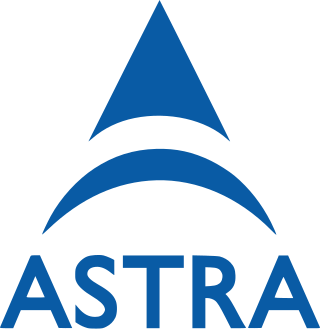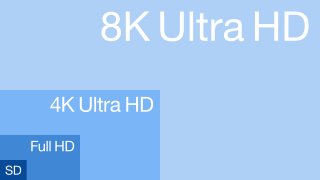
British Satellite Broadcasting (BSB) was a television company, headquartered in London, that provided direct broadcast satellite television services to the United Kingdom. They started broadcasting on 25 March 1990. The company was merged with Sky Television plc on 2 November 1990 to form British Sky Broadcasting.
This is a list of the satellites operated by Optus, an Australian telecommunications company. The satellite communications facility is located at Belrose on Sydney's Northern Beaches. Optus' satellites are divided into 4 classes A, B, C and D. As of April 2014 it owns and operates Optus B3, Optus C1, Optus D1, Optus D2 and Optus D3. Optus A1, Optus A2, Optus A3 and Optus B1 satellites have been retired. Optus has the largest network of satellites in Australia and New Zealand.

SES S.A. is a Luxembourgish satellite telecommunications network provider supplying video and data connectivity worldwide to broadcasters, content and internet service providers, mobile and fixed network operators, governments and institutions.

Intelsat I was the first commercial communications satellite to be placed in geosynchronous orbit, on April 6, 1965. It was built by the Space and Communications Group of Hughes Aircraft Company for COMSAT, which activated it on June 28, 1965. It was based on the Syncom series of satellites that Hughes had previously built for NASA to demonstrate that communications via synchronous-orbit satellite were feasible. Its booster was a Thrust Augmented Delta. After a series of maneuvers, it reached its geosynchronous orbital position over the Atlantic Ocean at 28° West longitude, where it was put into service.
Sky Television plc was a public limited company which operated a nine-channel satellite television service, launched by Rupert Murdoch's News International on 5 February 1989. Sky Television and its rival British Satellite Broadcasting suffered large financial losses, and merged on 2 November 1990 to form British Sky Broadcasting. A programming merger took effect on 1 December 1990.

The concept of television is the work of many individuals in the late 19th and early 20th centuries. The first practical transmissions of moving images over a radio system used mechanical rotating perforated disks to scan a scene into a time-varying signal that could be reconstructed at a receiver back into an approximation of the original image. Development of television was interrupted by the Second World War. After the end of the war, all-electronic methods of scanning and displaying images became standard. Several different standards for addition of color to transmitted images were developed with different regions using technically incompatible signal standards. Television broadcasting expanded rapidly after World War II, becoming an important mass medium for advertising, propaganda, and entertainment.
Astra 1E is one of the Astra communications satellites in geostationary orbit owned and operated by SES. It was launched in October 1995 to the Astra 19.2°E orbital slot initially to provide digital television and radio for direct-to-home (DTH) across Europe.

Satellite television is a service that delivers television programming to viewers by relaying it from a communications satellite orbiting the Earth directly to the viewer's location. The signals are received via an outdoor parabolic antenna commonly referred to as a satellite dish and a low-noise block downconverter.

NHK General TV, abbreviated on-screen as NHK G, is the main television service of NHK, the Japanese public broadcaster. Its programming includes news, drama, quiz/variety shows, music, sports, anime, and specials which compete directly with the output of its commercial counterparts. The channel is well known for its nightly newscasts, regular documentary specials, and popular historical dramas. Among the programs NHK General TV broadcasts are the annual New Year's Eve spectacular Kōhaku Uta Gassen, the year-long Taiga drama, and the daytime Asadora.
Türksat is the name of a series of Turkish communications satellites operated or projected by the state-owned Türksat A.Ş.
Multichannel television in the United States has been available since at least 1948. The United States is served by multichannel television through cable television systems, direct-broadcast satellite providers, and various other wireline video providers; among the largest television providers in the U.S. are DirecTV, Altice USA, Charter Communications, Comcast, Dish Network, and Verizon Communications. The Telecommunications Act of 1996 defines a multichannel video programming distributor (MVPD) as "a person such as, but not limited to, a cable operator, a multichannel multipoint distribution service, a direct broadcast satellite service, or a television receive-only satellite program distributor, who makes available for purchase, by subscribers or customers, multiple channels of video programming", where a channel is defined as a "signaling path provided by a cable television system."
High-definition television describes a television system which provides a substantially higher image resolution than the previous generation of technologies. The term has been used since 1936; in more recent times, it refers to the generation following standard-definition television (SDTV), often abbreviated to HDTV or HD-TV. It is the current de facto standard video format used in most broadcasts: terrestrial broadcast television, cable television, satellite television and Blu-ray Discs.
Astra 23.5°E is a group of Astra communications satellites co-located at the 23.5° east position in the Clarke Belt owned and operated by SES based in Betzdorf, Luxembourg. 23.5° east is one of the major TV satellite positions serving Europe.
The N-II or N-2 was a derivative of the American Delta rocket, produced under licence in Japan. It replaced the N-I-rocket in Japanese use. It used a Thor-ELT first stage, a Delta-F second stage, nine Castor SRMs, and on most flights either a Star-37E or Burner-2 upper stage, identical to the US Delta 0100 series configurations. Eight were launched between 1981 and 1987, before it was replaced by the H-I, which featured Japanese-produced upper stages. All eight launches were successful.

Astra 19.2°E is the name for the group of Astra communications satellites co-located at the 19.2°East orbital position in the Clarke Belt that are owned and operated by SES based in Betzdorf, Luxembourg.
Television in Japan was introduced in 1939. However, experiments date back to the 1920s, with Kenjiro Takayanagi's pioneering experiments in electronic television. Television broadcasting was halted by World War II, after which regular television broadcasting began in 1950. After Japan developed the first HDTV systems in the 1960s, MUSE/Hi-Vision was introduced in the 1970s.
Thor is a family of satellites designed, launched and tested by Hughes Space and Communications for British Satellite Broadcasting (BSB), and were used for Britain's Direct Broadcast Service. Thor is owned by Telenor. Marcopolo 1 launched on 27 August 1989 on the 187th launch of a Delta rocket, and Marcopolo 2 launched on 17 August 1990, on a Delta II rocket. Marcopolo I had the Hughes designation HS376.
Satellite television varies in the different regions around the world.

Ultra-high-definition television today includes 4K UHD and 8K UHD, which are two digital video formats with an aspect ratio of 16:9. These were first proposed by NHK Science & Technology Research Laboratories and later defined and approved by the International Telecommunication Union (ITU).







